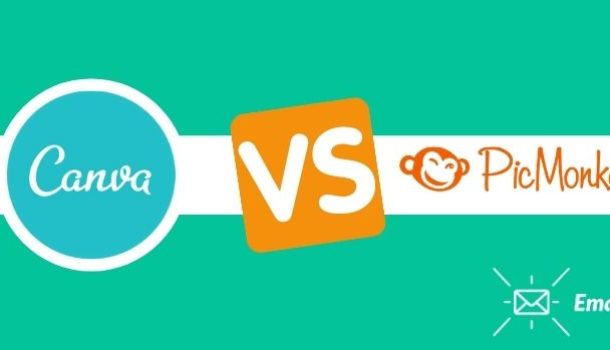Having amazing graphics on your website gives you an edge over your competitors. People love visual content.
It helps them consume what you have to offer in a different, much more refreshing way, which will keep them on your website much longer – long enough for them to convert into customers hopefully.
Canva and PicMonkey are two distinct platforms that will help you create professional-looking graphics with little to no training required.
You’re probably sitting there wondering which of the two would be a better choice for your business. Well, I guess you will have to read on and find out as I compare them.
Ease of Use
Both of these applications are really easy to use, so choosing the one that is easier is going to be tough.
Canva provides you with over 460 000 different design templates which you can choose then drag-and-drop the necessary media components into the blanks.
Learning how to use Canva will need an investment of only about 30 minutes or less which means anyone can use it, even a 7 year old.
PicMonkey on the other hand is almost as easy-to-use as Canva, but because they have a bit more robust photo-editing capabilities, you will take a bit longer to learn how to use it.
Ease of Use Score: Canva: 5/5 PicMonkey: 4/5
Canva uses drag-and-drop editing to make edits which most people can do, they take the first round.
Platform
Canva and PicMonkey are both great platforms to use depending on what you need done.
If you are looking for a software that allows you to create professional-looking graphics for social media and other platforms then you should go with Canva.
If you are looking for a software that allows you to edit and retouch your photos, then PicMonkey is for you.
Platform Score: Canva: 4/5 PicMonkey: 3/5
Canva is a better platform than PicMonkey mainly because it offers a variety of different tools and features at a very reasonable price.
Performance
Canva and PicMonkey are cloud-based which means that their performance is dependent on the speed of your internet connection.
Canva has lots of different tools and features that come with it so a stable internet connection is very necessary to run things smoothly. If perhaps you have a below than average connection then you should stick to the most basic design templates to avoid lag.
PicMonkey on the other hand, is not jam-packed with different tools and features which means the risk of lag is greatly reduced.
Performance Score: Canva: 4/5 PicMonkey: 5/5
PicMonkey scoops this round because it has fewer features and tools which makes its performance rather smoother.
Design Tools and Features
Design tools and features are what make or break a graphic design app. Both Canva and PicMonkey offer amazing tools and features that can revolutionize the way prospects and customers interact with your website.
Canva has more design tools and features than PicMonkey. They offer you:
- A drag-and-drop editor which allows you to edit your projects with relative ease.
- An avalanche of over 75 million media resources to edit your graphics.
- Animation creation and video editing capabilities
- Collaboration capabilities and much, much more.
PicMonkey has concentrated most of its efforts into creating a platform with remarkable tools for photo editing. They also give you the ability to create logos and customized illustrations.
Design Tools and Features Score: Canva: 4/5 PicMonkey: 3/5
Canva takes this round because they have so many features and tools that you can use to design your graphics.
Photo Editing Capabilities
Canva and PicMonkey offer great photo editing capabilities. Canva Photo Editor lets you edit your images at a very basic level though.
You can resize, trim, crop, add conversation bubbles and other minor stuff. All-in-all if you’re looking to customize your images in a more advanced way, I would not choose them.
PicMonkey was made specifically for photo editing by Frits Habermann who is also a co-creator of Adobe InDesign. You can do much more advanced edits and retouching with PicMonkey.
Their photo editor allows you to do face swaps, change effects on images, clone, blur images, cropping and other creative edits.
Photo Editing Capabilities Score: Canva: 3/5 PicMonkey: 4/5
PicMonkey takes this round because they have a much more robust photo editor than Canva.
Video Editing Capabilities
The Canva Video Editor will be useful to you only if you want to create simple videos for social media. With it you can create slideshows, YouTube intros, Instagram stories, etc. Canva supports popular video formats such as MP4, AVI, WMV, and MKV.
PicMonkey’s video editor is similar to Canva’s in that it is pretty basic. With it you can add stickers, text and other minor edits. One other downside to their video editor is that you can only upload and edit MP4 format videos that are less than 50MB.
Video Editing Capabilities Score: Canva: 2/5 PicMonkey: 2/5
Both platforms don’t concentrate on video editing that much so this round has a low tie score of 2/5.
Integrations & Plugins
Canva integrates seamlessly with third-party apps such as: Moovly, Duotone, Slice, ColorMix and Screen. Canva can also connect with photo sharing sites like Pixabay, Flickr and Pexel, etc.
For any developer who wants to integrate their apps or sites with Canva, they provide you with an API that will allow you to do your job. Canva has a WordPress plugin that can integrate with your site so that you can easily import your designs easily.
PicMonkey on the other hand integrates mainly with file sharing platforms such as Buffer, Facebook, Tumblr and YouTube. PicMonkey does not offer a WordPress plugin like Canva although if you are a developer you can get their API key and integrate it with your website.
Integrations and Plugins Score: Canva: 3/5 PicMonkey: 1/5
Canva has better integrations than PicMonkey so they take this round.
Price
The price for using these two are very similar. The pricing plan for Canva goes like this:
- The Canva Freemium Plan is completely free
- The Canva Pro Plan is $9.95 per month when billed annually
- The Canva Enterprise Plan is $30 monthly when billed annually
When we check out the PicMonkey pricing plan, we will find out that they offer a:
- 7 day trial for new users
- Basic Plan – which is $7.99 if you choose to pay monthly, or if you opt to pay annually you will have to pay a discounted price of $72.
- Pro Plan – which is $12.99 if you choose to pay monthly, or you can opt to pay the discounted price of $120 annum.
- Team Plan – which is $33.99 when billed monthly, or $299.88 when you opt for the annual subscription.
Pricing Score: Canva: 4/5 PicMonkey: 3/5
The Canva free plan helps it come out tops.
The overall score stands at: Canva: 29 PicMonkey: 27
This means that our champion for today’s comparison is Canva.
Conclusion
When to choose Canva: Choose Canva if you are looking for an all-round, easy to use design software.
When to choose PicMonkey: Choose PicMonkey if you want to do a bit more advanced edits to your photos, like photo retouches, removing dark spots and cloning, etc.

